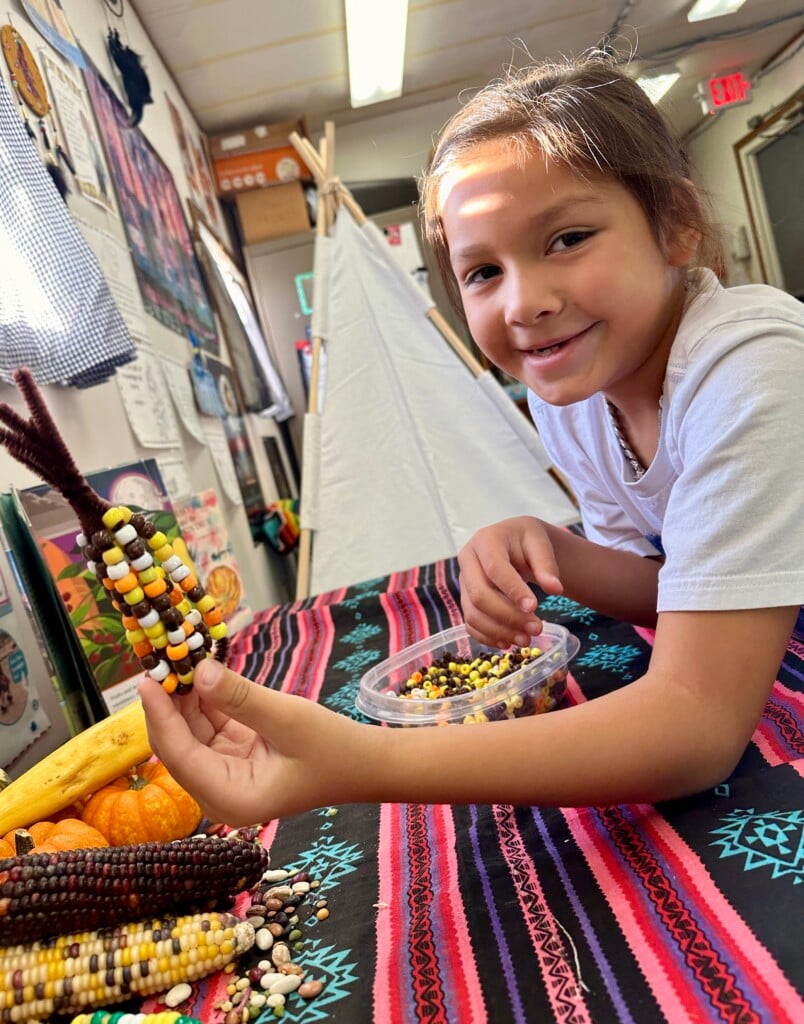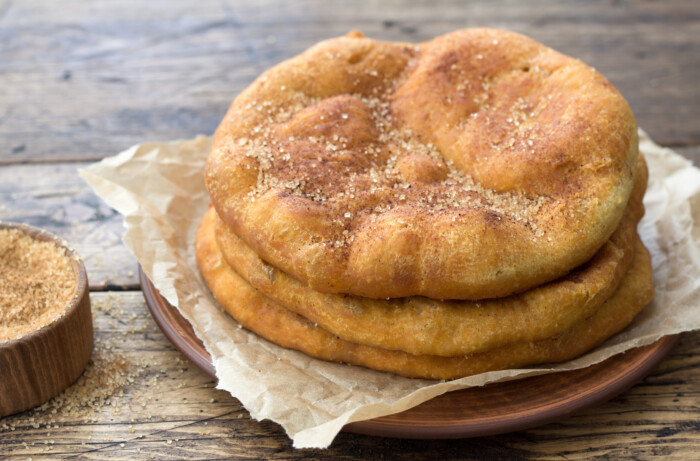A Delicious Way to Learn Native Culture

Fall is a season for gathering, cooking and telling stories. It’s the perfect time to explore the foods that connect us to the past. For many Native American families, food isn’t just about what’s on the table. It’s about the land, the seasons and the stories passed down from one generation to the next. Teaching kids about Native foods offers families a way to celebrate tradition while learning about the people who first grew the foods we love.
For Sand Springs teacher Stacy Clipp, sharing Native American culture with her students often starts with something familiar—food. As a member of the Cherokee Nation and an Indian Education teacher for Sand Springs Public Schools, Clipp uses traditional foods to spark curiosity and conversation. Through the smells, tastes and stories that come with traditional foods, she helps students see that Native culture isn’t something from the past, but rather something living and shared today.
In her own family, digging and frying wild onions is a cherished routine passed down through generations. It’s both a family custom and a beloved Cherokee tradition—one that brings people together to share in the work, the laughter and the satisfaction of preparing food from the land. It’s a chance for families to connect, share stories and be together.
For classroom lessons, Clipp ties food to storytelling, especially during the fall when she teaches about the Three Sisters: corn, beans and squash. One of her favorite books to use in teaching this unit is “The Three Sisters Garden.”
“‘The Three Sisters Garden’ and story is a vital part of Native American life: past, present and future,” Clipp said.
One of her favorite ways to make that lesson come alive is through a simple classroom craft of beaded corn. Using pipe cleaners and beads, students create colorful ears of corn while learning about the importance of corn to Native communities. This fun and hands-on project can easily be done at home, particularly in the days leading up to Thanksgiving. It’s a way for parents to talk with their kids about the early Native Americans who grew and relied on corn.
A Delicious Way to Learn
For families wanting to explore Native foods together, fall is the perfect time. Corn, beans and squash—the Three Sisters—can all be used to prepare a meal while learning the story behind them.
Families don’t need special ingredients or elaborate recipes to make Native food traditions meaningful. Try roasting corn, making a simple bean stew or reading a children’s book about the Three Sisters while dinner is cooking. These small activities help kids see that Native culture isn’t something far away or long ago, but rather woven into everyday life.
Whether through a bowl of wild onions, a story told from a kernel of corn’s point of view or a handful of beads strung together by small fingers, Native culture is worth discovering and exploring together.
This recipe, from the Cherokee National Tribal Youth Council and Cherokee Nation Public Health Program, is a good one to make with kids.
Cherokee Bean Bread
- 2 tablespoons bacon drippings or vegetable oil
- 2 cups yellow or white cornmeal
- 1 teaspoon salt
- 1 teaspoon baking powder
- ¼ teaspoon cayenne pepper (optional)
- 2 eggs, lightly beaten
- 1 ½ cups milk
- 2 cups cooked, drained pinto beans
- Preheat oven to 450 degrees. Place bacon drippings or oil in 10-inch cast iron skillet or 9-inch pan, and place in oven to heat.
- In a medium size bowl, stir together cornmeal, salt, baking powder and cayenne pepper (if desired).
- In a separate bowl, combine eggs and milk.
- Stir wet mixture into dry mixture. Drain beans, and spoon into batter.
- Remove hot pan from oven, pour batter in pan and bake for 20 minutes or until golden brown.
Grape dumplings were traditionally made from wild “possum grapes.” But grape juice from the grocery store is a good substitute today. Share in making this version from the Chickasaw Nation with your kids or grandkids.
Grape Dumplings
- 2 cups all-purpose flour
- 1 egg
- 1 ¼ cups water
- 1 tablespoon cornstarch
- 64 ounces grape juice
- Sugar, to taste
- Place flour in a heap on countertop. Make a well in center of flour and crack an egg in center. Using a fork, begin mixing the egg into the flour and add water as you go. Form the dough into a ball and roll out very thin. Cut into 1-inch squares.
- In a large pot place grape juice and sugar to taste. Bring to a rolling boil. Drop dumplings into boiling grape juice.
- Mix 1 tablespoon cornstarch in 1 cup water. Add to hot grape juice. Cook for a few minutes and serve hot.
This comforting soup is just what you want on a cool day. If your kids are meat lovers, you can start this soup by cooking 1/2-1 pound ground beef, which adds even more flavor and richness.
Three Sisters Soup
- 1 tablespoon olive oil or butter
- 1 small onion, chopped
- 2 cloves garlic, minced
- 1 medium carrot, chopped
- 2 cups peeled and cubed butternut squash
- ½ teaspoon ground cumin
- ½ teaspoon smoked paprika
- 1 teaspoon kosher salt
- ¼ teaspoon ground black pepper
- 1 (15-ounce) can diced tomatoes, with juices
- 4 cups vegetable or chicken broth
- 2 cups corn kernels (fresh, frozen or canned)
- 1 (15-ounce) can pinto beans or kidney beans, drained and rinsed
- 1 (15-ounce) can black beans, drained and rinsed
- Fresh cilantro or parsley
- In a large soup pot, heat olive oil or butter over medium heat. Add onion and carrot and cook 4-5 minutes or until softened. Stir in garlic and cook 1 minute more.
- Add cubed squash, cumin, smoked paprika, salt and pepper. Cook 5 minutes, stirring occasionally.
- Pour in broth and diced tomatoes. Bring to a boil, then reduce heat and simmer 10-15 minutes, until the squash is tender.
- Stir in corn, pinto beans and black beans. Simmer another 5-10 minutes to heat through and allow flavors to blend. Add more salt or seasoning if needed.
- Ladle into bowls and garnish with fresh herbs. Serve with cornbread or warm rolls.
This fall twist on traditional Native fry bread uses pumpkin for flavor and color. It’s soft on the inside and lightly sweet.
Pumpkin Fry Bread
- 2 cups all-purpose flour
- 2 teaspoons baking powder
- ½ teaspoon salt
- 2 tablespoons sugar
- ½ cup canned pumpkin puree
- ½ cup warm water (approximately)
- Oil for frying (vegetable or canola)
- Honey, maple syrup or cinnamon sugar for serving
- In a large bowl, stir together flour, baking powder, salt and sugar.
- Add pumpkin puree and warm water (you may need more or less than the ½ cup), stirring until a soft dough forms. The dough should be slightly sticky but not wet. Add a little more flour or water if needed.
- Cover with a towel and let rest for 20-30 minutes. This helps it relax and fry evenly.
- Heat 1-2 inches of oil in a heavy skillet over medium heat, around 350 degrees. Divide dough into 6-8 balls. Flatten each ball with your hands into a circle about ¼-inch thick (around 5 inches wide). You can poke a small hole in the center to help it cook evenly.
- Fry each piece 1-2 minutes per side until golden brown. Remove and drain on paper towels. Serve warm with honey, maple syrup or cinnamon sugar.
Children’s Books about Native culture
Stacy recommends these books for sharing Native American culture with children.
“Fry Bread” by Kevin Maillard
A warm and beautifully illustrated picture book that celebrates the modern and historical meaning of fry bread—a food born from hardship but transformed into a symbol of resilience and togetherness.
“Keepunumuk: Weeachumun’s Thanksgiving Story” by Danielle Greendeer, Anthony Perry and Alexis Bunten
Told from the perspective of the corn itself, this story shares a Native view of the first Thanksgiving, teaching respect for the land and for each other.
“Itse Selu: Cherokee Harvest Festival” by Daniel Pennington
A look at the importance of corn in Cherokee culture, paired with lively illustrations and activities. Perfect for pairing with a corn craft at home or school.
 Natalie Mikles is a mom of three. She writes about food, sharing recipes for busy families and picky eaters. Natalie Mikles has been recognized for her food columns as well as features on families and issues affecting local children. She loves pizza and movie nights with her family.
Natalie Mikles is a mom of three. She writes about food, sharing recipes for busy families and picky eaters. Natalie Mikles has been recognized for her food columns as well as features on families and issues affecting local children. She loves pizza and movie nights with her family.




